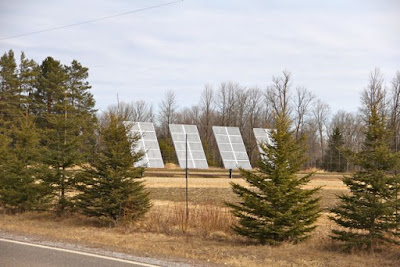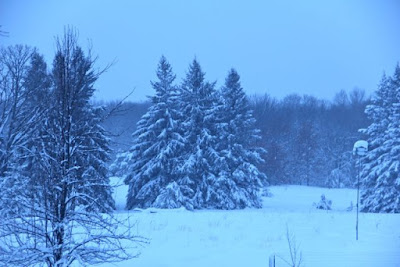No day is right for the apocalypse,
if you ask a housewife in Talking
Rock, Georgia, or maybe Hop River,
Connecticut. She is opening a plastic bag.
A grotesque parody of the primeval muck
starts oozing out. And behold,
the plastic bag is magic;
there is no closing it. Soap
in unsoftened water, sewage, asbestos
coiled like vermicelli, Masonite shavings,
a liquefied lifetime subscription
to The New York Times delivered all at once.
Empty body stockings, limp, forlorn,
like collapsed lungs. A blithering slur
of face creams, an army of photocopies
travelling on its stomach of acronyms,
tooth paste tubes wrung rigid and dry.
Also, two hundred and one tons
of crumpled bumpers wrapped in insurance
claims, slag, coal dust, plastic trimmings,
industrial excrementa. Lake Erie is returning
our gifts.
At first she thought she had won
something. Now it slithers through the house,
out windows, down the street, spreading
everywhere but heading, mostly, west.
Maybe heading is the wrong word,
implying shape and choice. It took
the shape of the landscape
it rippled across like the last blanket.
And it went west because the way lay open
once again: not the same fecund rug
the earth grew when white people scraped
their first paths to the Pacific
across the waves of the inland grasses.
Outside Ravenswood, West Virginia,
abandoned cars shine in the sun
like beetlebacks. The ore it took
to make the iron it took to make the steel
it took to make the cars, that ore
would remember the glaciers if it could.
Now comes another grinding, but not—
thanks to our new techniques—so slow.
The amiable cars wait stilly in their pasture.
Three Edsels forage in the southeast corner
like bishops of a ruined church.
There are Fords and Dodges, a Mercury
on blocks, four Darts and a Pierce Arrow,
a choir of silenced Chevrolets.
And, showing their lapsed trademarks
and proud grilles to a new westward
expansion, two Hudsons, a LaSalle
and a DeSoto.
I was hoping to describe
the colors of this industrial autumn—
rust, a faded purple like the dusty
skin of a Concord grape, flaking moss-
green paint with primer peeking
blandly through, the garish macho reds
insurance companies punish, the greys
(opaque) and silvers (bright), the snob colors
(e.g. British Racing Green), the two-tone
combinations time will spurn like roadkill
(1957: pink and grey), cornflower
blue, naval blue, royal blue, stark blue, true
blue, the blacker blue the diver sees
beneath him when he plumbs thirty feet—
but now they are all covered,
rolling and churning in the last
accident, like bubbles in lava.
And now my Cincinnati—the hills
above the river, the lawn that drained
toward Ricwood Ave. like a small valley of uncles,
the sultry river musk that slid
like a compromising note through my bedroom window—
and indeed all Cincinnati seethes. The vats
at Proctor & Gamble cease their slick
congealing, and my beloved birthplace
is but another whorl of dirt.
Up north near Lebanon and Troy and Rosewood,
the corn I skulked in as a boy
lays back its ears like a shamed dog.
Hair along the sow’s spine rises.
The Holstein pivots his massive head
toward where the barn stood; the spreading stain
he sees is his new owner.
What we imagined was the fire-storm,
or, failing that, the glacier.
Or we hoped we’d get off easy,
losing only California.
With the seismologists and mystics
we say the last California ridge
crumble into the ocean.
And we were read with elegies:
O California, sportswear
and defense contracts, gasses that induce
deference, high school girls
with their own cars, we wanted
to love you without pain.
O California, when you were moored to us
like a vast splinter of melon,
like a huge and garish gondola,
then we were happier, although
we showed it by easy contempt.
But now you are lost at sea,
your cargo of mudslides and Chardonnays
lost, the prints of the old movies
lost, the thick unlighted candles of the redwoods
snuffed in advance. On the ocean floor
they lie like hands of a broken clock.
O California, here we come,
quoting Ecclesiastes,
ruinous with self-knowledge.
Meanwhile, because the muck won’t stop
for lamentation, Kansas succumbs.
Drawn down by anklets of DDT,
the jayhawk circles lower and lower
while the sludge moils and crests.
Now we are about to lose our voices
we remember that tomorrow is our echo.
O the old songs, the good days:
bad faith and civil disobedience,
sloppy scholarship and tooth decay.
Now the age of footnotes is ours.
Ibid, ibid, ibid, ibid, ibid.
While the rivers thickened and fish
rose like vomit, the students of water
stamped each fish with its death date.
Don’t let a chance like this go by,
they thought, though it went by
as everything went by—towers
of water flecked by a confetti
of topsoil, clucked tongues, smug
prayers. What we paid too much for
and too little attention to,
our very lives, all jumbled
now and far too big in aggregate
to understand or mourn, goes by,
and all our eloquence places its
weight on the spare word goodbye.






















